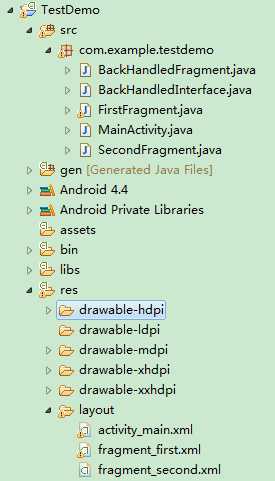标签:
1.首先贴上项目结构图:

2.先添加一个接口文件BackHandledInterface.java,定义一个setSelectedFragment方法用于设置当前加载的Fragment在栈顶,主界面MainActivity须实现此接口,代码如下:
package com.example.testdemo; public interface BackHandledInterface { public abstract void setSelectedFragment(BackHandledFragment selectedFragment); }
3.定义一个抽象类BackHandledFragment继承自Fragment,后面跳转的Fragment界面都要继承自BackHandledFragment。抽象类BackHandledFragment中定义一个返回值为boolean类型的onBackPressed方法,用于处理点击返回按键(物理Back键)时的逻辑,若该方法返回false,表示当前Fragment不消费返回事件,而由Fragment所属的FragmentActivity来处理这个事件。代码如下:
package com.example.testdemo; import android.os.Bundle; import android.support.v4.app.Fragment; public abstract class BackHandledFragment extends Fragment { protected BackHandledInterface mBackHandledInterface; /** * 所有继承BackHandledFragment的子类都将在这个方法中实现物理Back键按下后的逻辑 */ protected abstract boolean onBackPressed(); @Override public void onCreate(Bundle savedInstanceState) { super.onCreate(savedInstanceState); if (!(getActivity() instanceof BackHandledInterface)) { throw new ClassCastException( "Hosting Activity must implement BackHandledInterface"); } else { this.mBackHandledInterface = (BackHandledInterface) getActivity(); } } @Override public void onStart() { super.onStart(); // 告诉FragmentActivity,当前Fragment在栈顶 mBackHandledInterface.setSelectedFragment(this); } }
4.主界面MainActivity要继承FragmentActivity才能调用getSupportFragmentManager()方法来处理Fragment。MainActivity还需重写onBackPressed方法用来捕捉返回键(Back Key)事件,代码如下:
package com.example.testdemo; import android.os.Bundle; import android.support.v4.app.FragmentActivity; import android.support.v4.app.FragmentManager; import android.support.v4.app.FragmentTransaction; import android.view.View; import android.view.View.OnClickListener; import android.widget.Button; public class MainActivity extends FragmentActivity implements BackHandledInterface { private static MainActivity mInstance; private BackHandledFragment mBackHandedFragment; private Button btnSecond; @Override public void onCreate(Bundle savedInstanceState) { super.onCreate(savedInstanceState); setContentView(R.layout.activity_main); btnSecond = (Button) findViewById(R.id.btnSecond); btnSecond.setOnClickListener(new OnClickListener() { @Override public void onClick(View v) { FirstFragment first = new FirstFragment(); loadFragment(first); btnSecond.setVisibility(View.GONE); } }); } public static MainActivity getInstance() { if (mInstance == null) { mInstance = new MainActivity(); } return mInstance; } public void loadFragment(BackHandledFragment fragment) { BackHandledFragment second = fragment; FragmentManager fm = getSupportFragmentManager(); FragmentTransaction ft = fm.beginTransaction(); ft.replace(R.id.firstFragment, second, "other"); ft.addToBackStack("tag"); ft.commit(); } @Override public void setSelectedFragment(BackHandledFragment selectedFragment) { this.mBackHandedFragment = selectedFragment; } @Override public void onBackPressed() { if (mBackHandedFragment == null || !mBackHandedFragment.onBackPressed()) { if (getSupportFragmentManager().getBackStackEntryCount() == 0) { super.onBackPressed(); } else { if (getSupportFragmentManager().getBackStackEntryCount() == 1) { btnSecond.setVisibility(View.VISIBLE); } getSupportFragmentManager().popBackStack(); } } } }
5.分别添加两个子级Fragment,FirstFragment.java和SecondFragment.java,代码分别如下:
FirstFragment.java
package com.example.testdemo; import android.os.Bundle; import android.support.annotation.Nullable; import android.support.v4.app.FragmentManager; import android.support.v4.app.FragmentTransaction; import android.view.LayoutInflater; import android.view.View; import android.view.View.OnClickListener; import android.view.ViewGroup; import android.widget.Button; public class FirstFragment extends BackHandledFragment { private View myView; private Button btnSecond; @Override public View onCreateView(LayoutInflater inflater, @Nullable ViewGroup container, @Nullable Bundle savedInstanceState) { myView = inflater.inflate(R.layout.fragment_first, null); initView(); return myView; } private void initView() { btnSecond = (Button) myView.findViewById(R.id.btnSecond); btnSecond.setOnClickListener(new OnClickListener() { @Override public void onClick(View v) { SecondFragment second = new SecondFragment(); FragmentManager fm = getFragmentManager(); FragmentTransaction ft = fm.beginTransaction(); ft.replace(R.id.firstFragment, second); ft.addToBackStack("tag"); ft.commit(); } }); } @Override protected boolean onBackPressed() { return false; } }
SecondFragment.java
package com.example.testdemo; import android.os.Bundle; import android.support.annotation.Nullable; import android.view.LayoutInflater; import android.view.View; import android.view.ViewGroup; public class SecondFragment extends BackHandledFragment { private View mView; @Override public View onCreateView(LayoutInflater inflater, @Nullable ViewGroup container, @Nullable Bundle savedInstanceState) { mView = inflater.inflate(R.layout.fragment_second, null); return mView; } @Override protected boolean onBackPressed() { return false; } }
6.三个布局文件代码如下:
activity_main.xml
<RelativeLayout xmlns:android="http://schemas.android.com/apk/res/android" xmlns:tools="http://schemas.android.com/tools" android:layout_width="match_parent" android:layout_height="match_parent" android:orientation="vertical" > <TextView android:layout_width="wrap_content" android:layout_height="wrap_content" android:layout_centerInParent="true" android:text="FragmentActivity 父界面" android:textSize="26sp" /> <Button android:id="@+id/btnSecond" android:layout_width="wrap_content" android:layout_height="wrap_content" android:layout_alignParentBottom="true" android:text="跳转到FirstFragment" /> <FrameLayout android:id="@+id/firstFragment" android:layout_width="match_parent" android:layout_height="match_parent" > </FrameLayout> </RelativeLayout>
fragment_first.xml
<?xml version="1.0" encoding="utf-8"?> <RelativeLayout xmlns:android="http://schemas.android.com/apk/res/android" android:layout_width="match_parent" android:layout_height="match_parent" android:background="#e5e5e5" android:orientation="vertical" > <TextView android:layout_width="wrap_content" android:layout_height="wrap_content" android:layout_centerInParent="true" android:text="FirstFragment" android:textColor="#000000" android:textSize="26sp" /> <Button android:id="@+id/btnSecond" android:layout_width="wrap_content" android:layout_height="wrap_content" android:layout_alignParentBottom="true" android:text="打开SecondFragment" /> </RelativeLayout>
fragment_second.xml
<?xml version="1.0" encoding="utf-8"?> <RelativeLayout xmlns:android="http://schemas.android.com/apk/res/android" android:layout_width="match_parent" android:layout_height="match_parent" android:background="#e5e5e5" android:orientation="vertical" > <TextView android:layout_width="wrap_content" android:layout_height="wrap_content" android:layout_centerInParent="true" android:text="SecondFragment" android:textColor="#000000" android:textSize="26sp" /> </RelativeLayout>
Android 使用Fragment界面向下跳转并一级级返回
标签:
原文地址:http://www.cnblogs.com/zhujiabin/p/5453621.html